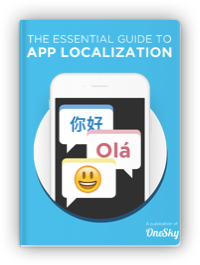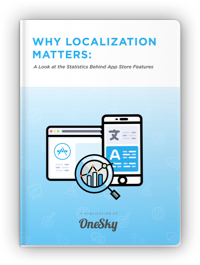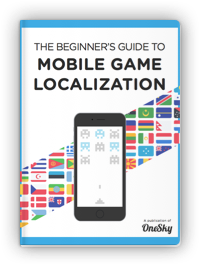Game Translation: How to Localize Your Game for International Success
The global video game industry is in the midst of an unprecedented expansion.
Revenue in the Games market worldwide is projected to reach US$522.46bn in 2025.
More impressively, over 3.3 billion players from different cultures, languages, and backgrounds are actively engaging with games across multiple platforms—be it PC, consoles, or mobile devices.
While creating innovative gameplay, captivating stories, and dazzling graphics is vital, there’s an often-overlooked ingredient that can significantly boost your game’s success overseas—game translation and localization.
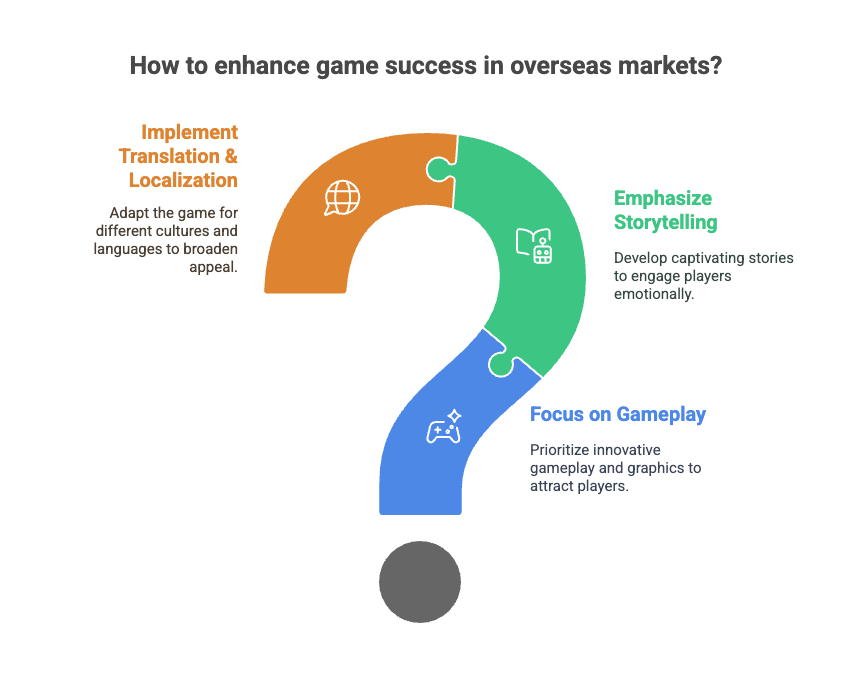
Imagine a captivating RPG designed for Western audiences suddenly hearing and reading the game’s dialogue in Japanese, with cultural references and humor adapted to resonate perfectly with local players.
When done correctly, game translation can transform a regional hit into a global phenomenon, expanding your reach, attracting millions of new players, and multiplying your revenue streams.
However, the path of effective game translation is complex.
It involves more than traditional language conversion—it’s an intricate blend of cultural insight, technical mastery, and adaptive storytelling.
And today, with the advent of AI and advanced content management systems, it’s possible to deliver high-quality localization at scale, faster and more cost-effectively than ever before.
In this article, we’ll explore in depth:
- What game translation really entails
- Why it’s crucial to your international success
- How to plan and execute it properly
- The challenges involved and how to overcome them
- The leading tools and technologies on the market
- Best practices and industry insights
Plus, we will analyze and compare some of the most popular game translation tools available today, so you can make informed decisions about how to streamline your localization process.
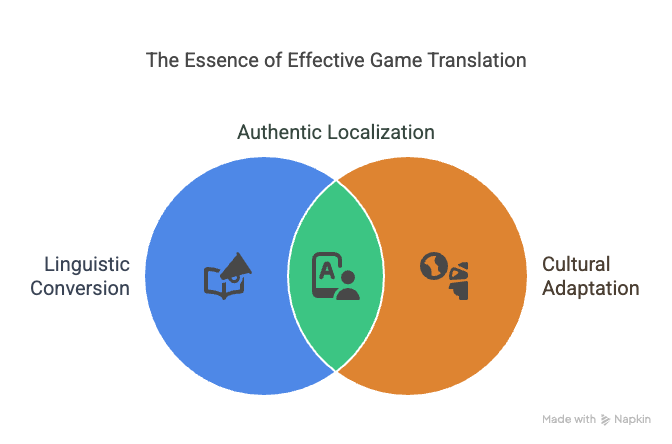
What Is Game Translation, and Why Is It So Important?
Defining Game Translation
At its core, game translation involves converting all of your game’s textual content into other languages.
This includes:
- Dialogue and voice-over scripts
- Menus and UI (user interface) elements
- Subtitles and captions
- Item descriptions, tutorials, and in-game instructions
- Legal disclaimers and age restrictions
- Marketing content, website information, and promotional material
But more than just translating words, successful game translation maintains:
- The tone, humor, and emotional impact
- Cultural nuances and references
- The gameplay flow and user experience

Game Localization: Beyond Simple Translation
While translation is a core component, localization expands to adapt visuals, symbols, character names, musical elements, and even gameplay mechanics to culturally suit target markets.
For example, a game set in New York might need to change street signs, references, or even color schemes to suit local sensitivities.
Localization is about making your game feel native, rather than foreign or imported.
It ensures that players in any country see, hear, and feel that the game was tailored just for their culture, language, and expectations.
Why Is Good Game Translation and Localization So Critical?
1. Player Engagement & Retention
Players are more likely to enjoy a game that speaks their language and cultural context.
A well-localized game conveys the humor, emotion, and cultural references in ways that resonate deeply, keeping players engaged longer.
2. Market Penetration and Revenue
Countries like China, Japan, Germany, and Brazil represent enormous markets. But without proper translation, your game risks being ignored or rejected.
3. Brand Reputation
A poorly translated or culturally insensitive game can damage your reputation, lead to negative reviews, censorship, or even bans.
4. Competitive Advantage
The gaming industry is more competitive than ever.
Investing in high-quality game translation can distinguish your game from the countless titles competing for attention.
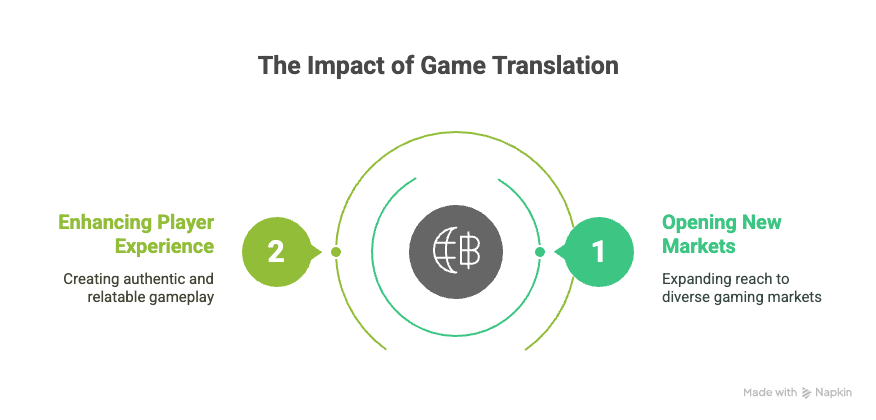
The Benefits of High-Quality Game Translation
1. Opening New Markets
Most successful modern games have global ambitions.
By translating your game into these languages, you unlock vast revenue streams and expand your brand’s reach.
2. Enhancing Player Experience
Localization makes your game feel authentic and relatable.
Humor that translates well, culturally relevant references, and local customs all enhance immersion.
This leads to:
- Higher player satisfaction
- Longer play
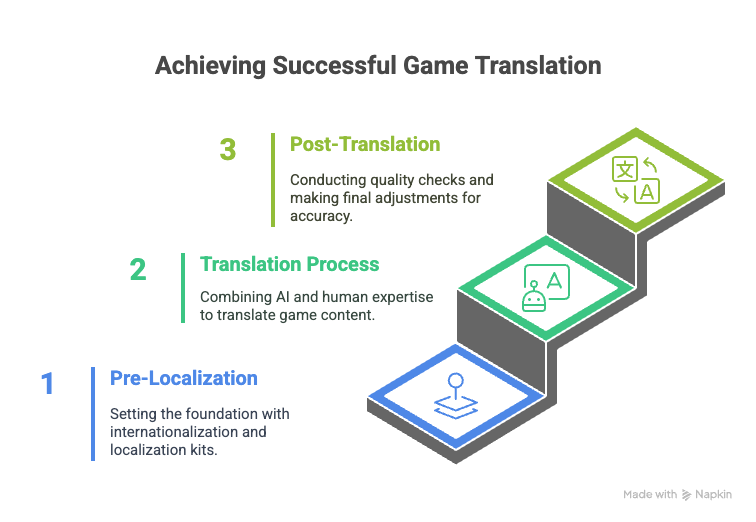 The Process of Game Translation—Step by Step
The Process of Game Translation—Step by Step
Developing a successful game translation strategy requires careful planning and execution.
It involves several critical phases, each essential for delivering a high-quality localized experience.
1. Pre-Localization: Setting a Strong Foundation
Internationalization (i18n) refers to preparing your game so that it supports multiple languages easily.
This means designing your game’s architecture to handle different character sets, date formats, UI layouts, and more—before you even start translation.
Building a Localization Kit is equally important. Think of it as your game’s blueprint for translation. This kit should include:
- Style guides—how to handle tone, humor, and terminology
- Glossaries of key terms and names
- Context explanations or screenshots to clarify ambiguous UI elements
- Character bios and storyline summaries
- Cultural notes on references or symbols
Platforms like OneSky make it easier to develop, store, and manage these resources collectively, ensuring consistency across all languages.
Partner early with professional localizers or agencies specializing in game translation. This collaboration helps set realistic timelines, budget, and expectations.
2. The Translation: Turning Text into Multiple Languages
Combining AI and Human Expertise is the cornerstone of modern game translation.
Advanced AI systems—like neural machine translation—handle initial translation drafts, which are then refined and polished by human linguists.
Content management becomes crucial here. With integrated platforms such as OneSky, developers can:
- Extract game strings automatically
- Share context-rich content with translators
- Track progress in real-time
- Make quick updates when in-game content changes
Providing context is key. Translators need to know:
- The purpose of text (e.g., is it a joke, a command, or a storyline element?)
- Gameplay flow, scene descriptions, or character moods
- Cultural nuances and sensitivities
This combined approach ensures accuracy, appropriateness, and consistency across all language versions.
3. Post-Translation: Quality Checks and Final Adjustments
Once translation files are ready, rigorous testing is vital.
This includes:
- Linguistic QA: Reviewing translations for grammatical errors, tone inconsistency, and cultural sensitivity.
- UI Testing: Ensuring translated text fits within UI elements and does not break layout or overlaps.
- Gameplay Testing: Confirming translated dialogues do not disrupt game flow or context.
- Cultural Review: Detecting possible offensive, confusing, or irrelevant content.
Modern tools like OneSky incorporate AI and machine learning algorithms to flag potential issues automatically. This saves time and improves localization accuracy.
Continuous localization is also a best practice.
As your game evolves—whether through updates, DLC, or patches—keep the translation process running efficiently with automation and AI-based workflows, reducing time-to-market for new content.
Leading Game Translation Tools in the Market
When it comes to game translation and localization, choosing the right tool can streamline workflows, improve quality, and reduce costs.
Here is an overview of some of the most popular and reliable tools used by industry leaders today:
| Tool | Key Features | Ideal For | Strengths | Limitations |
|---|---|---|---|---|
| SDL Trados Studio | Extensive translation memory, terminology management, support for complex formats | Large AAA titles, projects with detailed terminology | Industry standard, excellent for managing large, complex projects | High cost, complex to learn |
| memoQ | User-friendly interface, collaborative workflow, flexible project setup | Mid-sized teams, projects requiring collaboration | Easy to use, supports various file formats, customizable workflows | Performance issues on very large projects |
| Smartling | Cloud-based, real-time content updates, automation, support for continuous localization | Live online games, multiplayer titles needing frequent updates | Supports ongoing content, seamless team collaboration, automated workflows | Cost can be high; cloud dependency |
| OneSky | AI-powered multi-agent system, deep integration, content automation | Fast-paced projects, ongoing updates, multi-language scale | Scalable, reduces costs, fast turnaround, automation focus | Still evolving AI features; best for automating routine tasks |
| Lokalise | Cloud-based, flexible API integrations, glossary management | Agile teams, projects with frequent updates | Easy to use, supports multiple formats, supports continuous localization | Less advanced AI features compared to OneSky |
Analysis of Each Tool
1. SDL Trados Studio
Overview:
A long-standing leader in the translation industry, SDL Trados Studio is renowned for handling complex localization projects, especially those with intricate terminology and large volumes of content.
Strengths:
- Industry trust and reliability: Used by many top-tier localization agencies and publishers.
- Rich features: Robust translation memory, glossaries, and QA checks ensure consistency across multiple languages.
- Wide format support: Handles complex game files like XML, JSON, and proprietary formats.
Limitations:
- Learning curve: It takes time to learn and master features.
- Cost: It’s expensive, which may pose a challenge for smaller teams or indie developers.
- Workflow rigidity: Less suited for rapid, iterative updates typical in live games.
Ideal Use:
Large AAA titles, games with extensive terminology, or projects requiring precise control over translation assets.
2. memoQ
Overview:
A flexible and user-friendly CAT tool, memoQ is favored by many localization professionals for its adaptable workflows and strong collaboration features.
Strengths:
- Ease of use: Frequently praised for its intuitive interface.
- Collaboration support: Facilitates real-time teamwork on projects.
- Custom workflows: Supports automation and supports multiple file formats, including JSON and XML.
Limitations:
- Performance issues: On very large projects, it may slow down.
- Limited AI integration: Less automated compared to newer cloud-based tools.
Ideal Use:
Mid-sized teams or companies with complex projects requiring granular control.
3. Smartling
Overview:
A cloud-based platform that is designed for ongoing, continuous localization—ideal for live and multiplayer games requiring frequent updates.
Strengths:
- Supports ongoing updates: Perfect for DLC, patches, and live content.
- Easy collaboration: Cloud platform supports remote teams and rapid workflows.
- Automation: Integrates with your code repositories for smooth content updates.
Limitations:
- High cost: Might be prohibitive for smaller projects.
- Less control: Some limitations on workflows and customization, compared to on-premise tools.
Ideal Use:
Live service games, MMOs, multiplayer titles needing rapid content update cycles.
4. OneSky
Overview:
A modern, AI-powered platform focusing on scalable, automated game translation workflows, oriented toward developers needing fast turnaround and ongoing localization.
Strengths:
- Multi-agent AI system: Coordinates translation, review, and updates automatically.
- Deep integrations: Connects with GitHub, Bitbucket, and other repositories for seamless workflows.
- Content automation: Efficiently manages multi-language files and updates; ideal for scaling.
Limitations:
- AI features still evolving: Some tasks may need human oversight.
- Initial setup: Requires understanding of AI-assisted workflows.
Ideal Use:
Fast-paced, content-heavy projects, especially when minimizing costs and manual effort is a priority.
5. Lokalise
Overview:
Lokalise is a cloud-based localization management platform designed for efficient, collaborative, and ongoing game translation.
It integrates smoothly with development tools and supports rapid content updates.
Strengths:
- Easy to Use: Intuitive interface for all team members.
- Real-Time Collaboration: Supports multiple translators and reviewers.
- Supports Continuous Localization: Ideal for patches, DLC, and live updates.
- Strong Integrations: Works with GitHub, GitLab, Bitbucket, and more.
- Wide Format Support: Handles JSON, XML, YAML, etc.
- Visual Context: Screenshots and in-context editing improve translation accuracy.
Limitations:
- Limited Advanced AI: Lacks multi-agent AI automation.
- Pricing: Can be costly for small teams or projects.
- Dependence on Internet: Cloud-based platform needs reliable connection.
- Cultural Nuance Handling: Less automated cultural sensitivity tools.
Ideal Use:
- Mid-sized teams needing scalable workflows.
- Games with frequent updates requiring rapid localization.
- Developers seeking seamless team collaboration and integration.
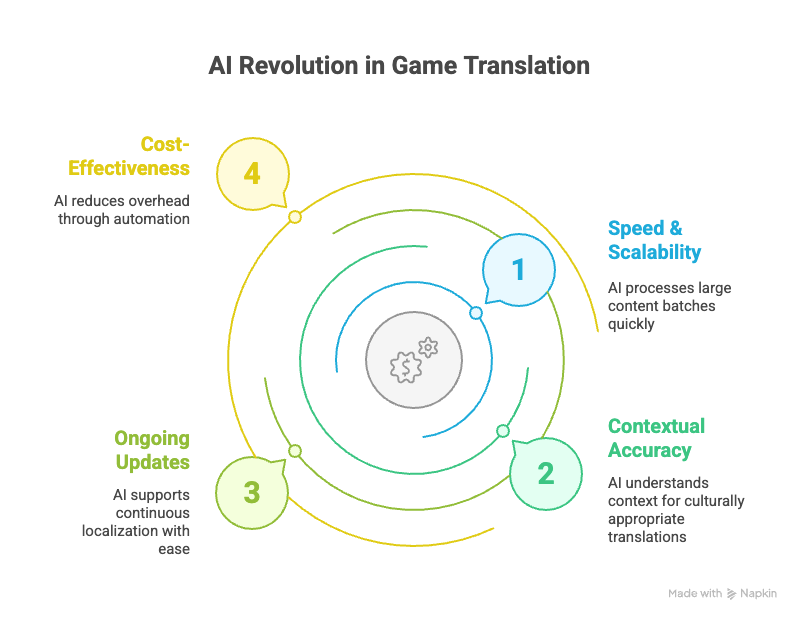
Why AI-Driven Platforms Are Revolutionizing Game Translation
In the past, translation involved manual workflows, which often meant long timelines, inconsistent terminology, and high costs.
Today, AI-powered platforms like OneSky are transforming the landscape:
- Speed & Scalability: AI helps process large batches of content quickly, perfect for multi-language releases.
- Contextual Accuracy: Multi-agent AI systems can understand the game’s context and suggest culturally appropriate translations.
- Ongoing Updates: AI workflows support continuous localization with minimal hassle, making live updates, patches, or new content rollout smoother.
- Cost-Effectiveness: Automating routine tasks reduces overhead, especially for multiple languages or frequent updates.
Read also: AI Translation: What It is, Top 10 Tools, What Future Holds

Key Challenges in Game Translation and How to Overcome Them
While current tools and processes have vastly improved, game translation still faces typical challenges:
1. Context Ambiguity
Without proper context, translators can misinterpret dialogue or UI elements.
Solution: Provide detailed background, storyboard snippets, screenshots, and gameplay notes. Many AI platforms like OneSky’s multi-agent system incorporate contextual data to guide better translations.
2. Text Length & UI Constraints
Translating English phrases into other languages often results in longer strings, risking overlaps or truncated text.
Solution: Use dynamic text resizing and flexible UI layouts. Automated systems can adjust length and formatting on the fly.
3. Cultural Sensitivities
Humor, symbols, or references may offend target audiences if not localized carefully.
Solution: Automatic scans detect sensitive content, and AI-recommender systems help suggest culturally appropriate alternatives.
4. Technical Compatibility
Differences in date formats, currencies, text directionality, or character sets can cause issues.
Solution: Internationalization best practices, supported by tools like OneSky, allow content adaptation without breaking compatibility.
5. Managing Multiple Languages
Handling dozens of languages with consistent terminology and tone is a high demand.
Solution: Translation memories and glossaries in platforms like SDL Trados ensure consistent branding and terminology across all languages.
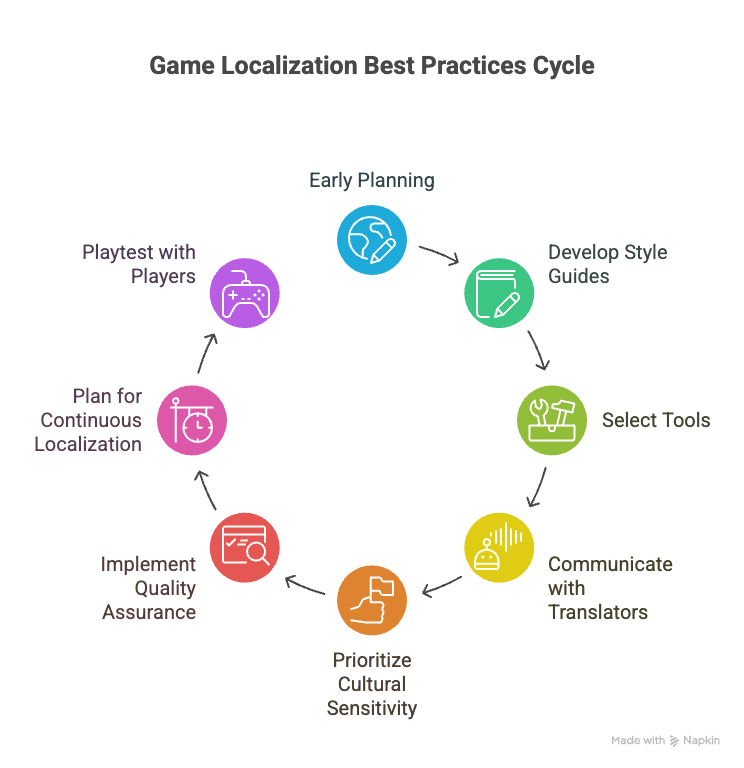
Best Practices for Effective Game Translation and Localization
To maximize your game’s success across markets, follow these industry best practices:
1. Early Planning & Internationalization
Begin internationalization during initial development stages.
Design your game’s code to support multilingual content, handle different character sets, and allow flexible UI layout adjustments.
2. Develop Detailed Style Guides & Glossaries
Create comprehensive glossaries specifying terminology, character names, tone, humor, and cultural references.
Tools like OneSky or Lokalise help manage these resources and keep everyone aligned.
3. Use the Right Tools & Processes
Select tools that fit your project size, scope, and budget:
- For large, complex projects, SDL Trados or memoQ.
- For rapid updates and ongoing content, OneSky or Smartling.
- For small to mid-sized teams, Lokalise or Crowd Content.
4. Communicate Clearly with Translators
Provide all relevant context—story summaries, gameplay descriptions, cultural notes—to ensure translations are accurate and appropriate.
5. Prioritize Cultural Sensitivity
Test translations with native speakers and local gamers.
Adjust humor, symbols, and references to avoid cultural crises.
6. Implement Rigorous Quality Assurance
Thoroughly review all localized content before release.
This includes:
- Conducting linguistic QA to catch grammatical, spelling, and tone issues.
- UI/UX testing to ensure text fits well within design constraints.
- Cultural reviews to avoid offending or confusing players.
- Automated checks using AI tools to flag potential issues early—systems like OneSky’s multi-agent AI can assist here.
7. Plan for Continuous Localization
Content updates, patches, and new downloadable content are a given in modern gaming.
Setting up workflows to handle these efficiently is crucial.
AI-driven tools support rapid translation of new content, reduce costs, and ensure consistency across updates, keeping your game fresh and engaging.
8. Playtest with Real Players
Before launch, test your localized game with native speakers and local players.
Their feedback will reveal if humor, references, and gameplay are culturally relevant and understandable.
Adjust as needed and iterate to perfect the experience.
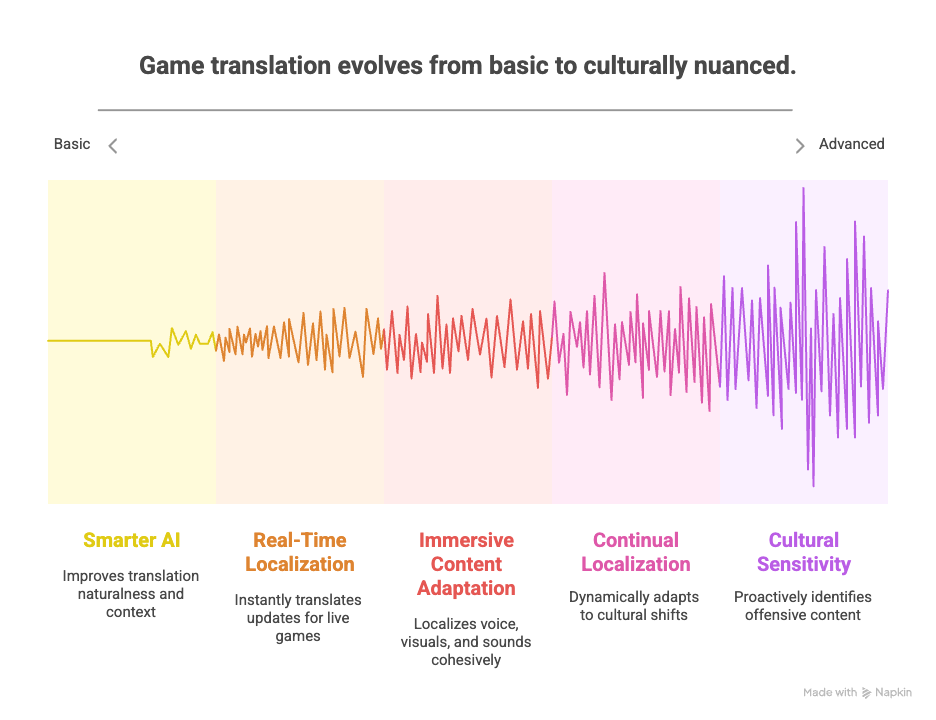
The Future of Game Translation — Trends and Innovations
The world of game translation is rapidly evolving, driven by technology, player expectations, and the demands of live content.
Here’s what we can expect in the coming years:
1. Smarter AI and Neural Machine Translation (NMT)
Advances in AI, especially neural networks, are making translations more natural and context-aware.
These systems understand subtleties like humor, idioms, and emotional tone much better than earlier models.
For example:
- Multi-agent AI systems like OneSky’s platform orchestrate multiple AI modules working together—context understanding, style adaptation, and cultural sensitivity—delivering high-quality output quickly.
- AI is no longer just a tool for rough drafts; it’s becoming an essential part of professional game localization workflows.
2. Real-Time Localization for Live Games
Multiplayer online games, especially MMOs and battle royales, constantly update with new content, patches, and expansions.
Real-time translation allows these updates to be localized instantly:
- Player chats, menus, and in-game notifications can be translated on the fly.
- Players from different regions can interact seamlessly, enhancing the social experience.
3. Immersive Content Adaptation
Virtual reality (VR), augmented reality (AR), and mixed reality games demand much more sophisticated game translation workflows:
- Voice and facial expressions need to be localized along with scripts.
- Visual cues, symbols, and sounds must be adapted to fit cultural norms.
- AI-driven localization supports translating these complex assets simultaneously, ensuring a cohesive experience.
4. Continual Localization & Content Management
With live services and big online communities, localization isn’t a one-and-done process.
AI and automation will support:
- Ongoing translation of live content, updates, and user-generated content.
- Dynamic adaptation to cultural shifts or sensitivities as regions evolve.
5. Increased Focus on Cultural Sensitivity & Ethical Localization
AI will enhance localization by proactively identifying potentially offensive content, symbols, or references.
This reduces incidents of cultural missteps, maintains brand reputation, and strengthens global player trust.
Read also: Agentic AI Translation: Exploring The Future of Translation
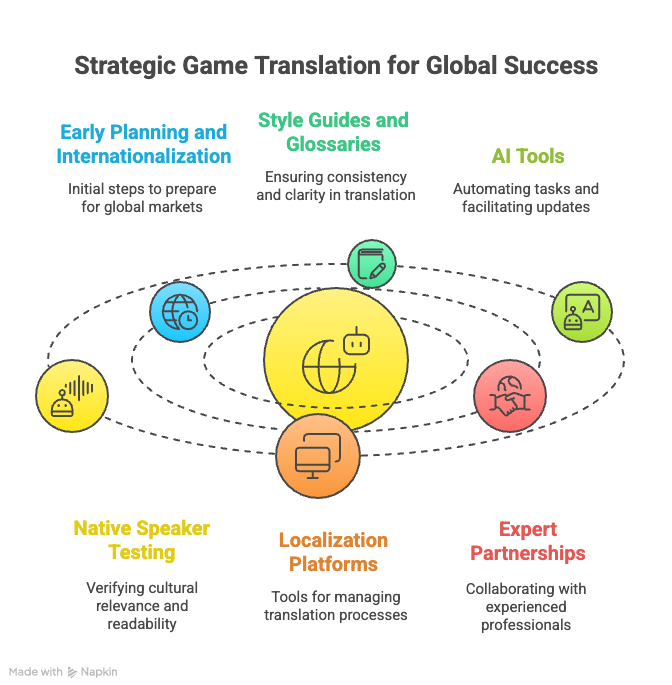 Why Strategic Game Translation Is Your Gateway to Global Success
Why Strategic Game Translation Is Your Gateway to Global Success
As the gaming market expands into new territories, game translation becomes more than just language conversion—it’s a strategic tool for global growth.
Properly localized games foster deeper engagement, help you stand out from competitors, and maximize revenue opportunities worldwide.
The best approach combines:
- Early planning and internationalization
- Clear, detailed style guides and glossaries
- Use of advanced AI tools like OneSky to automate routine tasks and facilitate continuous updates
- Regular testing with native speakers to gauge cultural relevance and readability
By leveraging these practices and technologies, your game can resonate meaningfully with players in every region, transforming it into a global sensation.
Actionable Next Steps
1. Assess Your Project Needs
Do you need fast ongoing localization for live updates or comprehensive localization for a big launch?
Your answer will guide your tool selection.
2. Choose the Right Localization Platform
For large, complex titles, tools like SDL Trados or memoQ are reliable.
For fast-paced, live updates, platforms like OneSky, with AI-powered workflows, offer significant advantages.
3. Create a Detailed Localization Strategy
Build glossaries, style guides, and context notes early.
Use AI tools to manage and update these resources across all content.
4. Partner with Experts
Work with experienced game translation agencies or platforms.
They bring not only linguistic expertise but also the technological capabilities to handle modern localization challenges.
5. Test and Iterate
Conduct thorough testing with native speakers and local players.
Local feedback is invaluable for refining humor, references, and gameplay experience.
6. Invest in Ongoing Localization
As your game evolves, leverage automation to keep translations current, relevant, and culturally appropriate across all markets.
Final Thoughts
The future of game translation is promising, driven by AI and evolving workflows.
Embrace best practices and technology to ensure impactful, culturally sensitive localization.
Choose the right tools and partners to turn your game into a global sensation.
Are you ready to elevate your game’s global reach?
Discover how OneSky can help streamline, automate, and scale your game translation workflows.
Contact us today to learn how our AI-driven solutions can turn your localization challenges into opportunities for worldwide success.

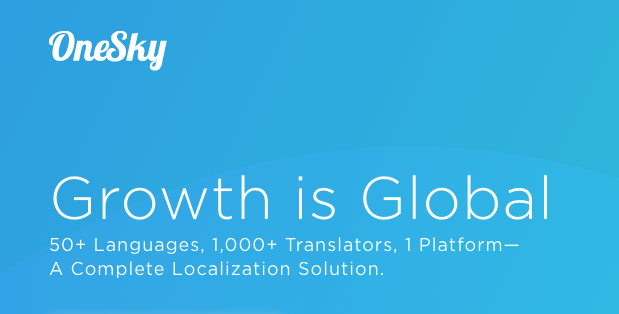
 Written by -
Written by - 
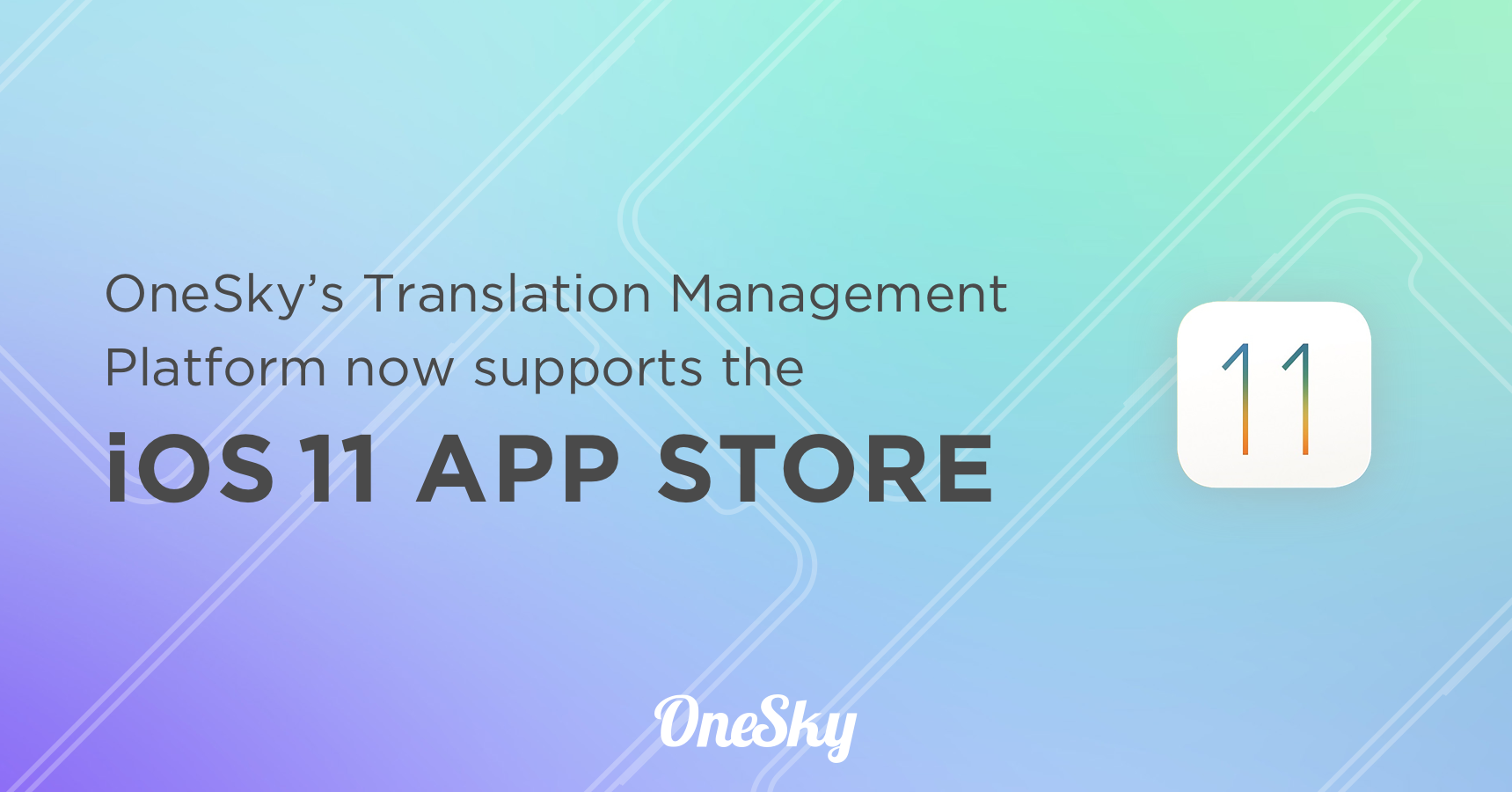
 Written by
Written by 
